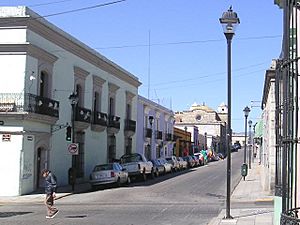Capture of Oaxaca (1812) facts for kids
Quick facts for kids Capture of Oaxaca |
|||||||
|---|---|---|---|---|---|---|---|
| Part of the Mexican War of Independence | |||||||
 A street view from the colonial part of Oaxaca, taken by Morelos in 1812. |
|||||||
|
|||||||
| Belligerents | |||||||
| Commanders and leaders | |||||||
| Strength | |||||||
| ~5,000 soldiers | 2,000 soldiers | ||||||
The Capture of Oaxaca was an important battle during the Mexican War of Independence. It happened on November 25, 1812, in Oaxaca, Oaxaca, Mexico. This fight was between the royalist forces, who were loyal to the Spanish king, and the Mexican insurgents. The royalist forces were led by General Antonio Pío González-Saravia Mollinedo. The Mexican insurgents, who wanted Mexico to be free from Spain, were led by José María Morelos y Pavón. The battle ended with a big victory for the Mexican insurgents.
Contents
How the Battle for Oaxaca Started
José María Morelos was in Tehuacán, Puebla when he found out that Spanish troops were coming to attack him. He decided to gather his soldiers and leave Tehuacán. Morelos had several important generals with him. These included Hermenegildo Galeana, Víctor Bravo, Miguel Bravo, Nicolás Bravo, Juan Pablo Galeana de los Ríos, and Mariano Matamoros y Guridi.
Morelos's Army Prepares
His colonels, like Vicente Ramón Guerrero Saldaña (who later became a president of Mexico) and José Miguel Ramón Adaucto Fernández y Félix, also joined him. All these forces came together to form a large army. They had over 5,000 soldiers and 40 artillery cannons. This strong army started marching towards Oaxaca on November 10, 1812.
New Leaders and Plans
Before heading to Oaxaca, Morelos made an important change. He promoted Mariano Matamoros to a very high position. Matamoros became the marshal of the army and Morelos's second-in-command. This meant Matamoros would take charge if anything happened to Morelos. When Morelos arrived at Villa de Etla, Oaxaca, he made a plan to attack the city of Oaxaca. He sent a message to General González Saravia, who was defending the city. Morelos asked him to surrender right away. But the message was not answered, so Morelos decided to take the city by force.
The Battle for Oaxaca City
On November 25, 1812, the insurgent army got into position and began their attack. Colonel Manuel Montaño climbed up the nearby mountainside to the Cerro de la Soledad. His goal was to cut off the city's water supply. He also wanted to stop any Spanish soldiers from escaping towards Santo Domingo Tehuantepec.
Insurgent Positions
General Hermenegildo Galeana led the front part of the army, called the vanguard. Miguel Bravo commanded the middle group of soldiers. Mariano Matamoros y Guridi was in charge of the rearguard, which protected the back of the army. Morelos himself led a group of cavalry (soldiers on horseback). A large part of the infantry (foot soldiers) stayed in reserve. They would be used later if needed during the battle.
Taking the Fort
The Spanish royalist forces controlled a fort at Cerro de la Soledad. This fort used its cannons to stop the main insurgent advance for some time. Morelos thought his army was not in a good position to attack directly. So, he sent Colonels Ramón Sesma and Manuel de Mier y Terán to capture the fort on the mountain. They tried to move a cannon closer to the fort to help their attack. But they soon found themselves under heavy fire from two sides and had to leave the cannon. Morelos then decided to send more soldiers to help Mier and Terán. Eventually, they succeeded in taking the fort.
The Final Push
Once the insurgents captured the fort, the main attack on Oaxaca began. They used an eight-pound cannon to support their advance. The royalist troops fought back at first. But as the battle continued, they could not keep up their strong defense. Finally, the Spanish commander ordered his soldiers to retreat. The last part of the battle was at a strong position called the Juego de Pelota (which means "ball game"). This place was protected by a moat (a deep ditch filled with water) and trenches.
Insurgent soldiers were unsure about attacking this well-defended spot. Then, Guadalupe Victoria bravely threw his sword across the moat. He shouted, ¡va mi espada en prenda, voy por ella! This means, There goes my sword, I will go and get it! He then swam across the moat, inspiring his friends to follow him. Together, they successfully captured the position.
Why Oaxaca Was Important
Losing Oaxaca was a very important victory for the insurgents. It was a big problem for the Viceroyalty of New Spain, which was the Spanish government in Mexico. For the insurgents, taking Oaxaca showed how skilled and strong Morelos was as a military leader. It also gave the insurgents a key location. From Oaxaca, they could control the areas around it, which was a big step towards Mexico's independence.
See also
 In Spanish: Toma de Oaxaca (1812) para niños
In Spanish: Toma de Oaxaca (1812) para niños

